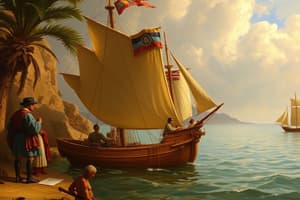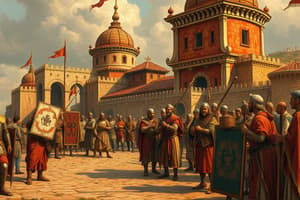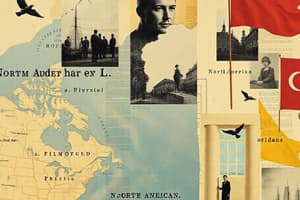Podcast
Questions and Answers
What was the primary purpose of Cartier's voyages?
What was the primary purpose of Cartier's voyages?
- To find a direct route to Asia via the Northwest Passage (correct)
- To document Indigenous cultures
- To conquer and colonize Canada
- To establish trade relationships with Indigenous peoples
Which of the following obstacles did Cartier face during his voyages?
Which of the following obstacles did Cartier face during his voyages?
- Hostile weather conditions
- Lack of adequate supplies
- Incompatibility with French navigational tools
- Attacks from the Haudenosaunee (correct)
How did scurvy affect Cartier's crew during the second voyage?
How did scurvy affect Cartier's crew during the second voyage?
- They received an Indigenous remedy that helped them (correct)
- They abandoned their search for the Northwest Passage
- They were successfully cured by European medicine
- They made a permanent settlement at Stadacona
What did Cartier mistakenly believe he had discovered during his explorations?
What did Cartier mistakenly believe he had discovered during his explorations?
What significant impact did Cartier's explorations have on future European explorers?
What significant impact did Cartier's explorations have on future European explorers?
What significant event marked the end of Elizabeth I's reign?
What significant event marked the end of Elizabeth I's reign?
Which two countries invaded Germany during the Thirty Years War?
Which two countries invaded Germany during the Thirty Years War?
Who was tasked with founding the city of Quebec?
Who was tasked with founding the city of Quebec?
What happened to King Gustavus Adolphus on November 16th?
What happened to King Gustavus Adolphus on November 16th?
What type of oppression did Protestants face that led to the Thirty Years War?
What type of oppression did Protestants face that led to the Thirty Years War?
What was a consequence of Samuel de Champlain's voyage in 1603?
What was a consequence of Samuel de Champlain's voyage in 1603?
Which of the following best describes Samuel de Champlain's relationship with the Iroquois?
Which of the following best describes Samuel de Champlain's relationship with the Iroquois?
What was included in Samuel de Champlain's notable work?
What was included in Samuel de Champlain's notable work?
Which of John Cabot's voyages was a failure due to bad weather?
Which of John Cabot's voyages was a failure due to bad weather?
What significant discovery did John Cabot make during his second voyage?
What significant discovery did John Cabot make during his second voyage?
What was one consequence of increased contact between Europeans and Indigenous people?
What was one consequence of increased contact between Europeans and Indigenous people?
What did the Beothuk people do in response to the French and British fishing camps?
What did the Beothuk people do in response to the French and British fishing camps?
What was the ultimate fate of John Cabot during his third voyage?
What was the ultimate fate of John Cabot during his third voyage?
What was a primary reason Europeans sought new routes to Asia?
What was a primary reason Europeans sought new routes to Asia?
Where was Jacques Cartier born?
Where was Jacques Cartier born?
What did King Henry VII grant John Cabot in 1496?
What did King Henry VII grant John Cabot in 1496?
Flashcards
John Cabot (Giovanni Caboto)
John Cabot (Giovanni Caboto)
A European explorer born in Genoa, Italy, known for being the first European to land in North America. He explored for the British Crown and made three voyages.
John Cabot's First Voyage (1496)
John Cabot's First Voyage (1496)
John Cabot's first voyage in 1496, which failed due to bad weather, forcing him to turn back.
John Cabot's Second Voyage (1497)
John Cabot's Second Voyage (1497)
John Cabot's successful 1497 voyage where he landed in Newfoundland and Labrador, discovering abundant cod fish. This voyage, while successful in finding fishing grounds, disappointed King Henry VII as it did not lead to a route to Asia.
John Cabot's Third Voyage (1498)
John Cabot's Third Voyage (1498)
Signup and view all the flashcards
Cartier's First Voyage (1534)
Cartier's First Voyage (1534)
Signup and view all the flashcards
Cartier's Second Voyage (1535-1536)
Cartier's Second Voyage (1535-1536)
Signup and view all the flashcards
Cartier's Third Voyage (1540)
Cartier's Third Voyage (1540)
Signup and view all the flashcards
Legacy of Cartier's Voyages
Legacy of Cartier's Voyages
Signup and view all the flashcards
Results of Cartier's Voyages
Results of Cartier's Voyages
Signup and view all the flashcards
Thirty Years' War
Thirty Years' War
Signup and view all the flashcards
Start of Slavery in the Americas
Start of Slavery in the Americas
Signup and view all the flashcards
Who was Samuel de Champlain?
Who was Samuel de Champlain?
Signup and view all the flashcards
What was Champlain's main objective?
What was Champlain's main objective?
Signup and view all the flashcards
What conflicts arose in New France?
What conflicts arose in New France?
Signup and view all the flashcards
How did Champlain contribute to the development of Quebec?
How did Champlain contribute to the development of Quebec?
Signup and view all the flashcards
Why is Champlain important in North American history?
Why is Champlain important in North American history?
Signup and view all the flashcards
Did Champlain cause the Iroquois-Algonquin war?
Did Champlain cause the Iroquois-Algonquin war?
Signup and view all the flashcards
Study Notes
Exploration of North America
- Columbus landed in South America, encountering the Aztecs
- Europeans sought a new trade route to Asia, as the Silk Road became dangerous
- Giovanni Caboto (John Cabot) was born in Genoa, Italy.
- He was commissioned by England to explore lands for the crown and was the first known European to land in North America
- Cabot had three voyages
- First voyage (1496) was unsuccessful due to bad weather
- Second voyage (1497) was successful
- Landed in Newfoundland and Labrador
- Found codfish, but King Henry VII was disappointed with a lack of a route to Asia
- Signs of indigenous people were seen.
- More Europeans came to Canada for fishing and trading
- Contact with indigenous people increased, resulting in significant trading
- Fur trade flourished, alongside the exchange of tools and implements.
- Increased contact led to the spread of disease among indigenous populations.
- Conflict arose between Europeans and indigenous groups.
- The Beothuk people became extinct.
Samuel de Champlain
- Samuel de Champlain contacted various indigenous groups (Algonquin, Iroquois, Tadoussac, Montagnais, and the Mi'kmaq)
- Gustavus Adolphus of Sweden defeated the Holy Roman Empire
- Gustavus Adolphus fell in Battle of Lützen in 1632.
- He was a French explorer, navigator, geographer, and expedition leader.
- He founded Quebec City
- He mapped areas of the Great Lakes
- He died in 1635 (Christmas day)
- He married Helen Boulé
Other Historical Events
- French and British exploration of and conflicts with Indigenous groups in Newfoundland and surrounding areas.
- Canada had already been colonized when Europeans tried to find a northwest passage to Asia.
- Cartier led an expedition to the Atlantic coast of Canada and the US
- Cartier was not experienced, but was commissioned by the King of France in 1534 to find a Northwest passage.
- Cartier tried to set up a French colony in Canada (1540/1543), but it was unsuccessful.
Studying That Suits You
Use AI to generate personalized quizzes and flashcards to suit your learning preferences.




